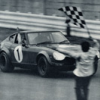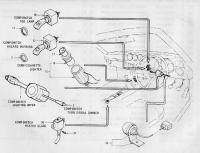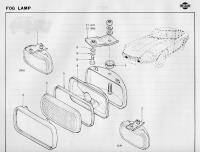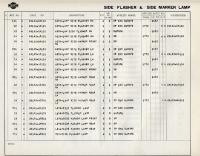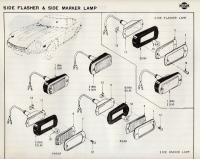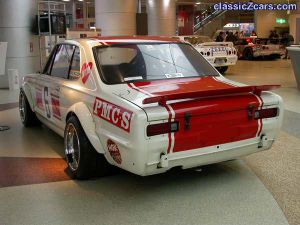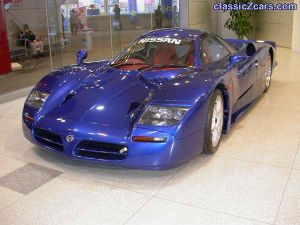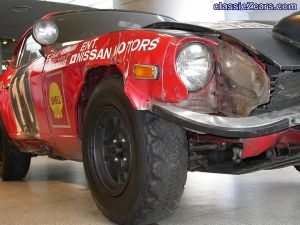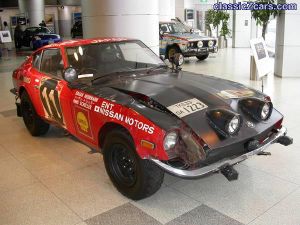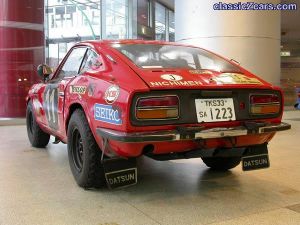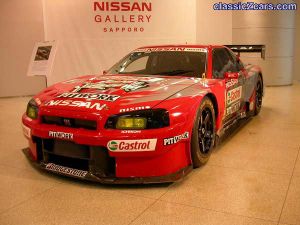Everything posted by HS30-H
-
NEW Wooden Steering Wheel
Didn't we get the real story on this subject a few months ago? I think it was Kats who spoke to Matsuo san about it, and Matsuo san confirmed that the original steering wheels were indeed made from wood... It was a new process at the time, and involved pressing wood into a mould ( under huge pressure ) and combining it with some sort of resin? I don't remember the thread it was on, but I think I'm remembering it correctly. So it IS wood, but not JUST wood:ermm: Alan T.
-
Fog Lamp Switch
26th-Z, The front-on photo of the car with the fog lamps is not an official Nissan photo. Its from the "Fairlady Z" book by Neko publishing, and I posted it on this site in relation to another fog lamp thread. The lamps in your other pics look very similar to the Nissan option ones, but not quite the same. Maybe they were made by the same manufacturer for another model? Actually, I don't know if the Z option fog lamps were made by Koito, Toshiba, Stanley, Ever Wing, or some other manufacturer. Anyone know? Alan T.
-
Quick rebuild of wiper arm pivots...
-
Fog Lamp Switch
Hi DJACEY, The illustrations come from the Nissan "R DRIVE" parts catalogs. These were issued to dealers, and were not sold to the general public. They are big and heavy files of illustrations and part number lists. Very substantial. Copying them would be a massive job as there are several hundred pages in each book. If you keep a lookout on ebay, or with the automotive literature dealers here in the UK, you can sometimes see them for sale. However, they tend to command quite high prices. Have you considered investing in the "Microfiche CD" which is sold on this site? Take a look at the top left hand corner of the main page and you will see that there is a special offer on them at the moment. This is a CD that has copies of the official Nissan parts microfiches for the early Z cars, and it is endorsed by Nissan USA. Even though they are more relevant to the LHD cars than the RHD cars, it might well be worth investing in one as many parts are exactly the same. I think every owner should endeavour to have this kind of data in their collection. They really are one of the best tools that you can invest in. Cheers, Alan T.
-
Fog Lamp Switch
-
Fog Lamp Switch
-
Side Flashers / Side Markers
PhilUK, Just to clarify - your car ( now in UK ) was originally an Australian-market car, and does NOT have the front indicator repeaters - am I correct? As I think I said before, only the very first TWO cars that came to the UK ( VIN numbers HS30-00034 & HS30-00035 ) came without the front indicator repeaters. If there were any others after that, then I for one did not notice! Most UK cars DID have them, but no rear markers. Mr Camouflage, I would imagine that they did indeed punch the holes in the panels as a seperate process, and this would have to be performed once the application of the panel was determined. ie - rear quarters for the USA / North American market would have to have the holes punched in them - but most other markets would not. That would necessitate a different part number for spare parts. The same would apply to front wings / guards / fenders - as anyone ordering spare parts would need to know whether they needed the type with the holes or without. This is what I mean about complicating matters with "optional" parts for certain markets. Steve ( sjcurtis ), I am fascinated that Australia and NZ got the mixture of cars both with and without the front indicator repeaters. In fact, I'm surprised that the front repeaters were offered as an 'optional' part, as I would have thought Nissan would want to keep things simple for themselves ( as they did with so many other things on these cars ). Alfadog, I'm wondering at what stage these front and rear repeaters / markers were added to the design. I reckon it was fairly late in the design process, and I have a hunch that the front came first and the rear came a bit later ( ? ). I think they would have been added out of necessity rather than for the sake of looks. Zedrally, I'm fascinated to hear that you actually bought that car NEW! Its very interesting that you chose to take what was available off the showroom floor, rather than to wait. The fact that it was already well specified must have been a big influence on your decision. Here in the UK I have heard the same kind of story; namely that the cars appeared to be so well equipped as "standard" that it was almost unnecessary to specify any further extras. It would appear that the dealers themselves were choosing colours and trim for the majority of cars that they would sell. This would be especially true in the UK, where the time between ordering a specific colour / trim / spec. package and actually receiving it would probably be longer than any other territory...... 26th-Z, I'm fascinated to hear about the holes for the rear markers on your car. Do you think this is evidence of hand-cutting? If so, it might indicate that the addition of the rear markers on the USA / North American market cars was an even later decision than we realise. Certainly I don't recall seeing them ( front or rear ) on the prototypes and pre-production models, at least until they appeared on those cars that went on the American / Canadian cold and hot weather tests in late 1969. The HLS30 "Export" spec. car on the Nissan stand at the 1969 Tokyo Auto Show DID have them ( I wonder what the VIN number of that car was? ). All the Japanese home-market cars had the fronts only. Alan T.
-
Side Flashers / Side Markers
What fascinates / confuses me is that there always seemed to be a very haphazard delivery situation with regard to these "Op" items. What I mean is, I have never actually heard of a person buying a new "HS30" ( here in the UK, back in the early Seventies ) being able to specify any of these "Option" parts. Of course, I was just a kid at the time, so I have no first-hand experience - but I have never heard or seen any evidence to show that prospective buyers were offered a list of options or choices at the time they were ordering their cars....... In fact, as far as I can surmise, the "Datsun UK" dealers simply sold what they had on the showroom floor. If anything, it was probably the dealers that decided what "options" would be on each car when they ordered them. What was the situation in Australia and NZ? Anybody know? Alan T.
-
My BEST Datsun Day.
I thought the discussion about front Flasher / Repeater units was interesting, so I've started a new thread on it here: Side Flasher / Repeaters thread All contributions / thoughts gratefully received. Cheers, Alan T.
-
Side Flashers / Side Markers
-
Side Flashers / Side Markers
Hi All, Following an interesting discussion in a recent thread with regard to the Side Flashers / Side Markers on "Export" RHD models ( HS30 ) I thought I would look into the subject a little more closely. Side Flasher discussion was contained in this thread The Nissan parts list books for the HS30 model show some useful and enlightening information on the fitment of the front Flasher / Repeaters. I knew that the first two HS30's to be imported to the UK did NOT have the front Flasher / Repeater units installed in the front wings / fenders / guards. However, these cars also had the conventional front Indicator / Flasher units mounted in the front valance corners ( same as the Japanese home market and USA / North American market cars ). These were found to contravene UK type approval regulations on lighting position, and Nissan were forced to re-design the front valance corners for the UK market cars and move the Indicators into a position on the front bumper. This took time, and delayed the first proper shipments of HS30 models destined for the UK. Apparently, the cars originally allocated to the UK market were re-allocated to the Australian market whilst the re-design for the UK market was carried out. All of the Japanese home-market cars used the front Flasher / Repeater units - regardless of whether they were the cheapest Fairlady Z 'base' model or the most expensive Fairlady 240ZG - but did NOT use the Rear Marker lamps. The USA / North American market models on the other hand seem to have always been fitted with both the front and rear Side Marker lamps. I thought it interesting that Nissan would bother to make dedicated front Wings / Guards / Fenders WITHOUT the cut-out for the front Side Flashers / Repeaters, for just one market. I know that this will not be of much interest to the majority of members, but it might well prove to be of interest to the owners of Australian and New Zealand market HS30 cars. It would certainly be nice to get on top of this and understand exactly what was going on, and maybe why. Here's a scan from the Nissan parts list book for the HS30 models:
-
Datsun 280ZX in London....
Hi daddz, No I've not seen it on London's roads ( I'm sure I would remember it! ) but then this IS a big town...... I remember a similar car being advertised for sale more than a year ago. I should imagine that its probably the same one. I'd be concerned about the condition. Its possibly pretty nasty underneath that bodykit, and the vendor even admits that its not as good now as it looks in the photos..... Its probably not going to sell unless he drops his price by a BIG percentage. Alan T.
-
My BEST Datsun Day.
Didn't know that. Wonder why they didn't have them? Must be a story behind that. Would it be a case of them not conforming to local laws? That's what happened with the very first UK-market cars. They had to put the first batch of imports on the back-burner while they re-configured the lighting.
-
R-Factory GT-R
Part of Nissan's "Ai no Skyline" advertising campaign, which led on to the ( very famous in Japan ) "Ken & Mary" couple character ads. Rough translation of "Ai no Skyline" would be "Skyline of love" or "Love Skyline". It was all very cheesey, but the TV and Cinema commercials were very well made with high production values. Really nice photography in them.
-
R390 GT1 road car
Yes Gav, they were sold to the general public - but it was really only a case of 'going through the motions' in order to meet the homologation regulations. In reality, most of the road cars belonged to Nissan or to closely related companies. TWR had a couple, and I'm not sure what has happened to them now that they have gone bust.
-
My BEST Datsun Day.
Steady on there. Less of the "Guru" stuff please! Most UK-market cars, and just about all Japanese-market cars, came with the front wing / fender indicator repeaters - but without the rear ones seen on the USA / Canada market cars. I don't have any data about when they stopped using the front ones on the Australian-market cars, but the early cars had them - didn't they? For the most part, I would expect the NZ-market cars to conform pretty closely to the Australian-market cars. Maybe there was the odd difference and change here and there? Considering the unexplained / undocumented spec. and component changes we see on most of the early "Export" RHD cars, I would not be surprised if there were some differences with other market versions of Export RHD cars. How's that for answering a question without answering it?! It looks a nice car, kyteler. I for one would like to hear more about it. Steve ( sjcurtis ) will be wanting VIN number / engine number data from it to add to his Export RHD database, I'm sure. I've heard about some nice early cars living in NZ, but have not seen pics of very many. Good to see! Cheers, Alan T.
-
I am puzzled on this one
No Guus, Two completely different cars. The car that Schuller / Weitman used on the Hugenotten Ralley was "TKS 33 SA 8514" ( a full "Works" car built in Japan ) - which Fall & Wood drove on the 1973 Monte Carlo Rally. It came back to Old Woking Service Station in the UK after the Hugenotten. Quite distinctive with its Overfenders and the sponsorship from "Nippon Speed Car". It must have had the Overfenders fitted after the Monte. Here's a pic:
-
I am puzzled on this one
1973 Tour De Corse. ( the island of Corsica - French territory, for those who might be wondering ). Crewed by Y. Nishimura & A. Tanaka. Fairlady 240Z - privateer car / privateer entry. Not a "Works" built car - but it had lots of Nissan Sports Option parts on it. Sponsored by Winston tobacco brand and Esso.They were journalists. They actually finished the rally ( no mean feat on its own ) and came in something like 18th as far as I remember. Alan T. :classic:
-
I am now Z less
That is GREAT news. If you need any little bits or pieces, let us know. I'm sure everybody will be more than happy to help out. Very happy for you.:classic: Alan T.
-
New Gallery section request
They're up! Exactly 23 pics. ( spot the significant number ). Thanks to our Administrators for creating the new section, and for approving the pics so quickly. This event saw Nissan celebrating another year of racing success ( the 2003 JGTC crown ) and linking it to their current product. All of the Nissan Gallery showrooms in Japan had a visit in 2003 from a selection of sporty models, and actual race cars, from Nissan's long history. Hope the pics prove of interest. Alan T.
-
71 Safari winner
-
71 Safari winner
-
71 Safari winner
-
R89-R90 Group C car
-
JGTC R34 Skyline GT-R




